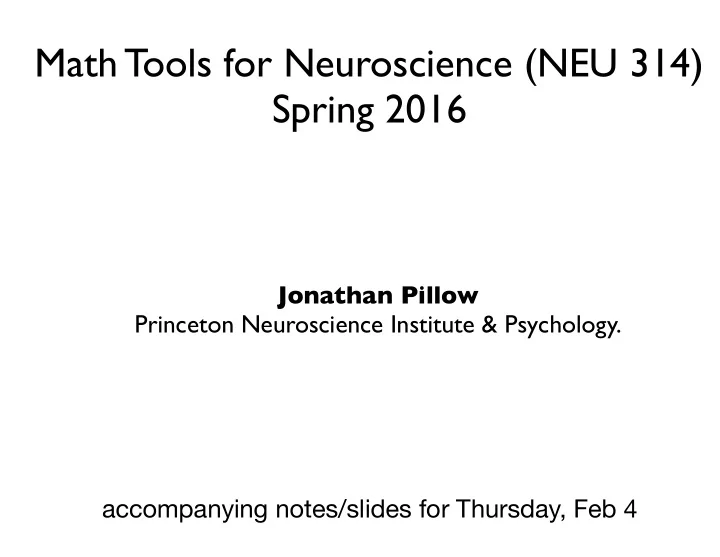

Math Tools for Neuroscience (NEU 314) Spring 2016 Jonathan Pillow Princeton Neuroscience Institute & Psychology. accompanying notes/slides for Thursday, Feb 4
discussion items • course website: http://pillowlab.princeton.edu/teaching/mathtools16/ • sign up for piazza. • take math-background poll • for Matlab newbies: • check out MATLAB for neuroscientists (Lewis Library), chapter 2 • either of the matlab tutorials posted on course website (just first part, up through vectors & matrices). • Today: “ Intro to linear algebra: vectors and some of the basic stuff you can do with ‘em.” • Next week: start of labs!
today’s topics • vectors (geometric picture) • vector addition • scalar multiplication • vector norm (“L2 norm”) • unit vectors • dot product (“inner product”) • linear projection • orthogonality
vectors v v 3 v 1 v v 2 v 2 v 2 � v = . . v v . 1 1 v N v N 1 v 2 v
column vector in matlab v 1 % make a 5-component v 2 % column vector � v = . . . v = [1; 7; 3; 0; 1]; v N transpose % transpose v' % create row vector by row vector % separating with , % instead of ; v = [1, 7, 3, 0, 1];
addition of vectors v translated w w v � v
scalar multiplication v 2 v v
vector norm (“L2 norm”) • vector length in Euclidean space v v 2 In 2-D: In n -D: v 1
vector norm (“L2 norm”) in matlab v = [1; 7; 3; 0; 1]; % make a vector % many equivalent ways to compute norm norm(v) sqrt(v'*v) sqrt(v(:).^2) sqrt(v(:).*v(:)) % note use of .* and .^, which operate % 'elementwise' on a matrix or vector
unit vector • vector such that v v 2 • in 2 dimensions v 1 unit circle
unit vector • vector such that • in n dimensions • sits on the surface of an n -dimensional hypersphere
unit vector • vector such that • make any vector into a unit vector via
inner product (aka “dot product”) • produces a scalar from two vectors w φ vw v b � b . v . w v . w w
linear projection • intuitively, dropping a vector down onto a linear surface at a right angle • if u is a unit vector, length of projection is v ^ u ^ ( . ) v u ^ u • for non-unit vector, length of projection =
linear projection • intuitively, dropping a vector down onto a linear surface at a right angle • if u is a unit vector, length of projection is v ^ u ^ ( . ) v u ^ u } component of v in direction of u • for non-unit vector, length of projection =
orthogonality • two vectors are orthogonal (or “perpendicular”) if their dot product is zero: v component of v orthogonal to u ^ u ^ ( . ) v u ^ u } component of v in direction of u
Recommend
More recommend